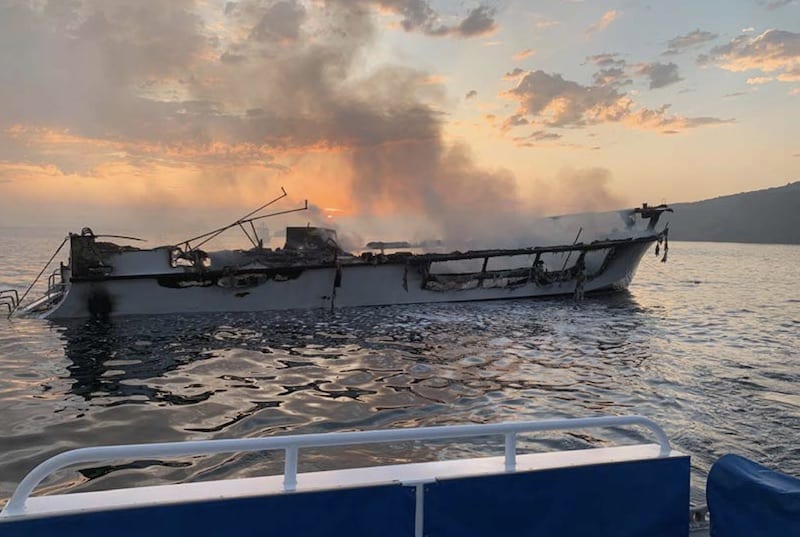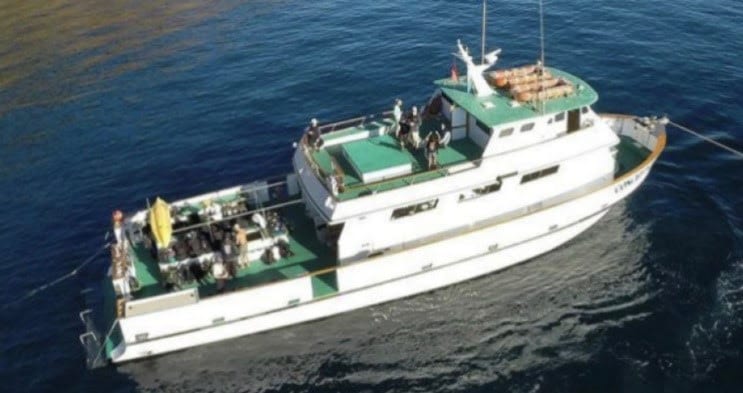Baltimore Bridge Wreck Removal: Fourth Body Recovered
April 15, 2024: Fourth Body Recovered Another missing victim was recovered at the Key Bridge incident site on April 14, 2024, and was identified today, the Unified Command report. The...


The commercial dive boat Conception at sunrise prior to sinking, September 2, 2019. (Source: Ventura County Fire Department)
The U.S. National Transportation Safety Board is calling for major safety improvements to small passenger vessels after its investigation into the 2019 Conception dive boat fire that killed 34 people, including all 33 passengers who were asleep in their bunks.
The NTSB on Tuesday held a board meeting to vote on the investigation’s findings, probable cause and recommendations, as well as any changes to the draft final report.
The 75-foot recreational diving vessel, Conception, with 33 passengers and six crew aboard, was anchored in Platts Harbor, off Santa Cruz Island in California when it caught fire in the early morning of Sept. 2, 2019.
All 33 passengers and one crewmember died of smoke inhalation after they were trapped in the berthing area while a fire raged on the deck above. Both exits from the berthing area led to the fire- and smoke-filled enclosed area above.
During Tuesday’s virtual board meeting, the NTSB determined the probable cause of the fire and subsequent sinking was the failure of Truth Aquatics, Inc., the owner and operator of Conception, to provide effective oversight of its vessel and crewmember operations, including requirements to ensure that a roving patrol was maintained, which allowed a fire of unknown cause to grow, undetected, in the vicinity of the aft salon on the main deck.
Contributing to the undetected growth of the fire was the lack of a Coast Guard regulatory requirement for smoke detection in all accommodation spaces. Contributing to the high loss of life were the inadequate emergency escape arrangements from the vessel’s bunkroom, as both exited into a compartment that was engulfed in fire, thereby preventing escape.


The NTSB called for all vessels similar to the Conception with overnight accommodations to be required to have interconnected smoke detectors in all passenger areas. It also recommended that a secondary means of escape lead into a different space than the primary exit, in case a single fire blocks both escape paths.
The NTSB called on the U.S. Coast Guard to develop and implement an inspection program to verify that roving patrols are conducted – as required – for the safety of sleeping passengers and crew. NTSB investigators found the absence of a required roving patrol on the Conception likely delayed the initial detection of the fire, allowed for its growth, precluded firefighting and evacuation efforts and directly led to the high number of fatalities in the accident.
The recommendations to the Coast Guard would apply to vessels, like the Conception, that are under 100 gross tons and have overnight accommodations for 49 or fewer passengers that fall under Subchapter T of federal marine regulations. The NTSB’s recommendation on interconnected smoke detectors, meaning when one smoke detector alarms the remaining detectors also alarm, also would apply to larger Subchapter K vessels.
The NTSB also reiterated its call for small passenger vessels to be required to implement a safety management system to improve the safety culture of vessel owners and operators.
While the Conception had smoke detectors in the below-deck berthing area, they were not connected to each other or the wheelhouse, and there were no smoke detectors in the salon, the common area above the sleeping quarters where investigators believe the fire started. Because of the fire damage to Conception, which burned to the water line and then sank, there was little physical evidence for investigators to establish exactly how, when and where the fire started.
“The Conception may have passed all Coast Guard inspections, but that did not make it safe,” said NTSB Chairman Robert L. Sumwalt. “Our new recommendations will make these vessels safer, but there is no rule change that can replace human vigilance.”
Join the gCaptain Club for curated content, insider opinions, and vibrant community discussions.


Join the 105,931 members that receive our newsletter.
Have a news tip? Let us know.
Access exclusive insights, engage in vibrant discussions, and gain perspectives from our CEO.
Sign Up




Maritime and offshore news trusted by our 105,931 members delivered daily straight to your inbox.



Essential news coupled with the finest maritime content sourced from across the globe.
Sign Up